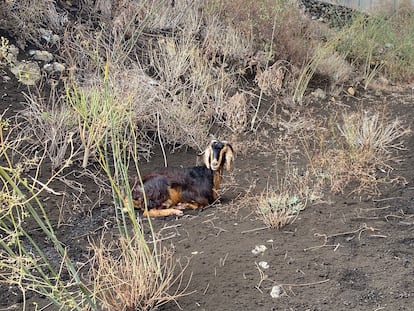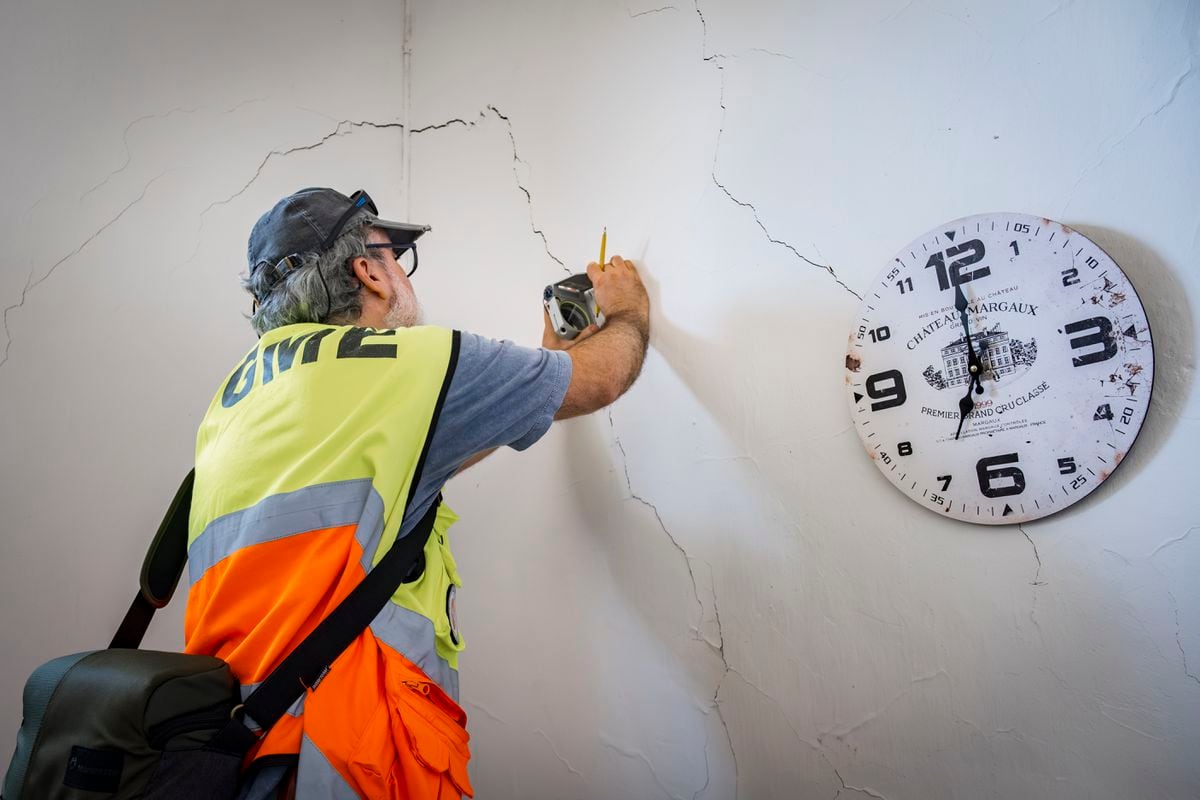"For wildlife, the scenario is that of a nuclear war."
Manuel Nogales has been studying Canarian biodiversity for 40 years and he is finding an alteration in the behavior of the animals of La Palma such as was not known until now.
Everything is surprises, he says.
"They are very scared with this phenomenon, all the fauna have changed their behavior," he explains accelerated early in the morning on Friday, after sleeping four hours, before launching again with his
jeep
to the island's exclusion zone: where only scientists go.
Nogales is also devastated when he recounts the situation in which the domestic animals released in the area most affected by the lava are found, "adrift", eating vegetation full of ash.
And the fishermen of Tazacorte, on the coast closest to the volcano, speak of a notable shortage of fish.
MORE INFORMATION
The two faces of La Palma after the volcano: from the desert malpaís to the ashes that will fertilize the earth
Nogales, CSIC delegate in the Canary Islands, spends the day next to the lava tongues, surrounded by volcanologists, “who are the real stars of the team”, but his job is very different. The biologist studies what is happening with the life of the environment. The plants, for example, are extremely dehydrated, and 40% are very withered and in very bad condition. But it is the animals that most concern this researcher from the Institute of Natural Products and Agrobiology (IPNA). In the area, the fauna basically consists of birds and reptiles, especially lizards, which are no longer found. “The lizards have practically disappeared from the terrain. Now we hardly see anything, ”says Nogales, who has recorded in his field work these days only 10% of what he would normally observe.
And when the lizards, the basis of the diet of many birds of prey, disappear, the entire ecosystem is altered.
"Kestrels try to capture birds, and that is something that surprises me because in the Canary Islands it is not normal," acknowledges the biologist.
In the area there are other raptors that include smaller birds in their menu, such as hawks or hawks, such as the tagarote.
“Those are indeed specialists in capturing birds.
But now the kestrels have to pull wherever they can, a completely unexpected change, because we do not know this totally new scenario ”, adds the researcher.
A fighting cock with wounds.Manuel Nogales
The rest of the birds have also altered their way of interacting with the environment. Before, when this scientist went to the field to write down all the contacts in a certain perimeter, most of the news he received of his presence was by acoustic means: his song. "Now, curiously, we see many more birds than we hear, completely the other way around than usual." The researcher concludes: “The fauna is changing its habits, its behaviors, definitely. The species have much less fear and fear of the presence of the human being, it is drawing our attention ”. Bats, which are dependent on insects, are still around.
But the scientist is dismayed when he talks about the animals that are in the restricted area, near the washings, in terrible situations. “We see quite a few animals that they had to release. And we see them very adrift. I don't know where these poor animals came from. Goats with smashed hooves, lost cats, peacocks, countless animals that give us a lot of grief ”, he admits. Fighting cocks have also been found, a practice of animal abuse that is prohibited, "but now they are in the wild and have fought each other," he says, while displaying devastating photographs of injured animals on his mobile. “The worst thing”, he emphasizes, “is that the vegetation is melted and many of these animals are herbivores, so they are eating food with ashes: it has a bad prognosis.For a biologist it is very hard ”.
A domestic goat photographed by Manuel Nogales in the area near the colada.Manuel Nogales
Nogales explains that since this eruption began, he has seen "life in black and white", full of volcanic ash.
"It is a scenario that I did not know," he says.
He also assures that his work is unpublished: trying to evaluate how the eruption of a volcano directly impacts on all the biodiversity that surrounds the volcanic flows.
"We have no idea, we have started from scratch, because the bibliography is practically non-existent, but it is also a unique opportunity to study it," he says.
His life for a few days consists of getting up early, jumping into the restricted area with the field notebook, studying biodiversity until late at night (guided by volcanologists to avoid risks), and starting over the next day.
"The fish flee"
The crisis scientific committee of the emergency plan said on Thursday that "it does not rule out that the increase in the emission of ash and its fall into the sea may be affecting the marine ecosystem" on the coasts of La Palma, which may cause "drastic changes" therefore, surveillance systems for volcanic materials in the sea will be strengthened. The Spanish Institute of Oceanography (IEO) has sent the scientific vessel
Ramón Margalef
to study what is happening on La Palma. To carry out a weathered seabed, looking for gas expulsions, bulges or fissures, but also to study how it affects biodiversity.
According to the IEO researcher Eugenio Fraile, who is part of the scientific crisis committee, they want to study everything that happens there: the physics and chemistry of the water, but also how the fish are. "We have testimonies from fishermen who speak that there is less, of a significant change in catches, but we do not have data: we have to go there, see if this is the case and determine what the causes are," says Fraile. They are also going to sample corals, which are capable of assimilating precursor gases in a setting like this.
Pedro Hernández, from the Fishermen's Association of Tazacorte, assures that they have had six months “of reduction in catches.
It has been one of the worst years we have had ”, he says.
His partner Fernando Gutiérrez was the president of the El Hierro fishermen's association when a similar crisis broke out and there was an underwater eruption: the Tagoro volcano.
“People run away, well fish too.
Here also the fishing stopped, but it is that it killed the fish of half the island.
We spent a year and a half without being able to fish, but with the half that was saved, we were able to recover the half that was lost, ”Gutiérrez recalls.
“This whim of nature”, Fraile recalls, “comes just 10 years after the underwater volcano affected the Mar de las Calmas in El Hierro, and now it is another marine reserve, La Palma, an area of high sensitivity, the one that is already being affected ”.
You can write to
us
at
javier@esmateria.com
and follow
MATERIA
on
,
and
, or sign up here to receive
our weekly newsletter
.



/cloudfront-eu-central-1.images.arcpublishing.com/prisa/OFGUQXGFNJD63MDPUGKCDU7QHA.jpg)


